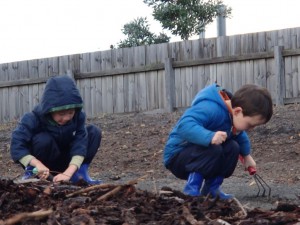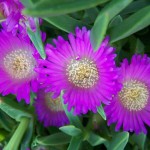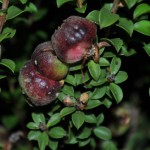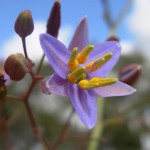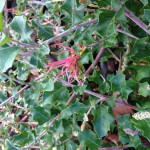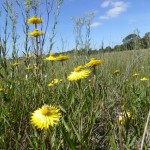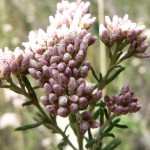
Portland Native Plant Display Garden
The Portland Native Plant Display Garden is a result of a partnership between the Portland Community Garden Landcare Group and Nature Glenelg Trust. You will also find vegetable gardens, a fruit orchard, and community meeting space at the Henry Street site.
The garden was planted in July 2014, with the assistance of about 25 volunteers from the Landcare group and the public. More than 1200 individual plants were planted from over 40 species. The large garden has a number of distinct areas and beds, each with a different focus or purpose.
As the garden grows and changes we may add more species – check back here to keep up to date!
Edible Plants
In the edible plant garden bed you will find a wide range of plants which have been traditionally used by local Indigenous peoples, and are experiencing a rise in popularity with the current bush tucker trend.
Pigface (Carpobrotus rossii), Bower Spinach (Tetragonia implexicoma), and Muntries (Kunzea pomifera) are groundcovers which grow in coastal dune areas and act as a dune stabilisers. Pigface has thick fleshy leaves and its fruits are edible – in fact its name (Carpobrotus) comes from the Greek for ‘edible fruit’. Bower Spinach may grow along the ground, or climb up other plants. Its leaves can be enjoyed steamed (like regular spinach) and it also provides a food source for lizards and birds.
Muntries grow prostrate (that is, as a groundcover) and may cover an area of several metres. Its purple berries are popular with birds, lizards, ants, insects and people! You can often find Muntrie jam, chutney or even muffins in speciality stores – watch out for it, next time you’re at your local café or store. Berries are also produced by the Native Raspberry (Rubus parvifolius) which fruits in autumn and can be used to make jams and preserves.
Unlike the other plants in this section, it is the roots and seeds of the Austral Trefoil (Lotus australis) which can be consumed. It grows to about 30cm, and its white or pink pea flowers attract birds and insects.
Wetland Plants
A variety of water plants can be found growing in the pond, such as Water Ribbons (Triglochin procera), Milfoils (Myriophyllum spp.), and Austral Brook-lime (Gratiola peruviana) which will provide food and habitat for invertebrates and frogs. Frogs are very sensitive to their surroundings and are often called ‘bio-indicators’ meaning that their presence provides an indication as to the health of an ecosystem. Frogs are also beneficial visitors to any garden as they help control insects. You can attract frogs to your garden by avoiding chemical use, ensuring protection from cats and dogs, providing sheltering plants and maintaining moist areas year-round.
Growing around the pond you can see a number of different sedges (Carex spp.). Curly Sedge (Carex tasmanica) is listed as a nationally Vulnerable species, while Tall Sedge (Carex appressa) and Rush Sedge (Carex tereticaulis) were traditionally used by local Indigenous people to weave baskets and eel traps. The leaves of the Swamp Flax-Lily (Dianella callicarpa) were similarly used for weaving, and its purple fruit attract a variety of birds.
Annual and Perennial Wildflowers
This bed is planted with low growing perennials so that the view from the deck overlooking the garden can be maintained for years to come. The coastal variety of the Holly Grevillea (Grevillea aquifolium) is a rare Victorian and South Australian plant which grows along the ground, or prostrate, rarely higher than 50cm tall. Its prickly holly-shaped leaves provide protection for little creatures to hide from predators and its red flowers are popular with birds and butterflies.
Grass Trigger-plants (Stylidium graminifolium) have developed an interesting adaptation to ensure pollination – when an insect touches a sensitive part of the flower the ‘trigger’ snaps forward and covers the insect in pollen. The insect then carries the pollen to another plant helping to maximise genetic diversity and resilience within the species.
Lemon Beauty-heads (Calocephalus citreus) and the nationally vulnerable Swamp Everlastings (Xerochrysum palustre) will put on a spectacular display of colour each spring with their bright yellow flowers. The Swamp Everlastings are particularly vibrant, however, there are only 35 known populations in the wild. They are found growing in wetlands including sedge-swamps and shallow freshwater marshes, often on heavy black clay soils. Have you seen this plant? We’d love to hear about it, so that we can help in its recovery.
Taller Shrubs and Trees
Taller shrubs and trees were planted towards the back of the garden to serve several purposes – firstly, to screen the back fence creating an attractive enclosed space; secondly, to add height diversity and interest to the garden; and finally, to provide safe places for wildlife. Along with butterflies and bees, birds are an essential ingredient in any successful garden as they assist in pollination. Prickly or dense shrubs like Sweet Bursaria (Bursaria spinosa) and Gorse Bitter-pea (Daviesia ulicifolia) provide safe places for birds to hide from predators.
The Portland area is famous for its beautiful Correas and several varieties are planted in this garden. With their bell-shaped flowers, all varieties are attractive to both birds and gardeners alike. Native Broom (Viminaria juncea) is a hardy and fast-growing shrub which can be found across much of Australia. From September to January it displays brilliant sprays of yellow pea-shaped flowers.
The largest plants in the garden are the rare Bog Gums (Eucalyptus kitsoniana) which grow to about 10 m and have cream or white flowers. Bog Gums can be found growing in marshy soil around southern Victoria. They have been planted in strategic locations to provide shade for both the plants below and visitors to the garden.
Grasses and Sedges
Prior to European arrival in Australia grasslands were much more extensive than they are today; in fact less than one percent of pre-European settlement grassland now remains. Grasslands can support a diverse range of life-forms, from all types of insects, to reptiles, mammals and everything in between. Birds love the seeds of Tussock Grasses (Poa spp.) and caterpillars thrive on Mat-rush (Lomandra spp.) leaves.
Rare and Threatened Plants
The Wrinkled Cassinia (Cassinia rugata) is listed as Vulnerable under both the Commonwealth Environment Protection and Biodiversity Conservation Act 1999 and the Victorian Flora and Fauna Guarantee Act 1988. The species is endemic to a small area in southwest Victoria and Tasmania. Threats to the species include weed invasion, grazing, and altered fire regimes. Other threatened species include Swamp Everlasting (Vulnerable in Victoria), White Correa (Correa alba – rare in Victoria), Curly Sedge (Carex tasmanica – Vulnerable in Australia and Victoria), Trailing Hop-bush (Dodonaea procumbens – Vulnerable in Australia and Victoria), Holly Grevillea (Rare in Victoria), Native Broom (Viminaria juncea – Rare in Victoria), and Bog Gum (Eucalyptus kitsoniana – Rare in Victoria).

